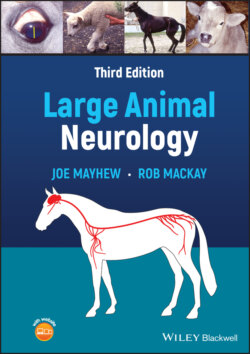Читать книгу Large Animal Neurology - Joe Mayhew - Страница 113
10 Miosis, mydriasis, anisocoria, and Horner syndrome
ОглавлениеDegrees of miosis (constricted pupil), mydriasis (dilated pupil), and anisocoria (asymmetric pupil size) occur in many ocular diseases, often accompanied by degrees of visual impairment. Large animal patients are not very frequently presented because of these problems alone; however, identifying them on a neurologic examination greatly helps in localizing the lesion. Texts discussing the evaluation and treatment of eye problems in large animals should be consulted for ophthalmic diseases.1–6
The pupillary constriction (CN III) and dilation (ocular sympathetic) pathways should be reviewed (Figure 2.7 and 2.8). Normal resting pupil size will depend on the emotional state of the patient and the amount of ambient light reaching the retinas. Usually, a nonfrightened large animal patient has a brisk initial pupillary light reflex (PLR). However, a common problem uncounted during examination is the patient blinking when a light is directed into one eye—the dazzle response—thus hiding the initial fast constrictive phase of the PLR. This can be averted by allowing the patient to accustom to the light, starting at say 30–40 cm from the eyes, swinging it from focusing into each eye in turn while moving closer, and observing for tapetal reflexes that highlight pupillary diameters. After determining pupil size and symmetry, the PLR can be assessed using a one second bright light flash directed to the area centralis in the midlateral (temporal) field where photoreceptor density is greatest. Interpretation should consider the phenomena of pupil escape following light‐on, and the postillumination pupil response occurring after light‐off (Figure 10.1).
Figure 10.1 Diagram of pupillary response to light‐on and to light‐off. Note that latency to start of constriction from light‐on is ~200ms.
Source: Modified from Hall and Chilcott,9 figure 1 (CC BY 4.0).
Of interest here is the newly recognized, intrinsically photosensitive, retinal ganglion cells (ipRGCs), which rely on a unique photopigment, melanopsin, and they are now known to have a major role in nonvisual light pathways including the PLR. Use of red and blue light PLR testing has now allowed the testing of retinal cell subpopulations.7–9 In general terms, low intensity, dark‐adapted (scotopic), blue light PLR tests rod function, high intensity, dark adapted, blue light tests ipRGC function, and high intensity, photopic, red light PLR tests cone function. Better understanding of the details of such testing and use of handheld pupilometers10 will allow for a more accurate assessment of visual and light pathways in our large animals.11
Results of pupillary responses to the swinging light test are useful here as in the evaluation of vision. Consider a bright and alert patient with rather complex responses to visual and light pathway testing. The patient has no menace response but has a normal palpebral response to touch, and is blind with a widely dilated pupil, all in the left eye. There is a normal menace response in the right eye, and light shone in the right eye results in the right pupil constricting and also in a positive dazzle (blink) response. When the light is then swung briskly to enter the left eye, the left pupil is and remains dilated and there is no dazzle response in the left eye. When the light is then quickly retransferred to enter the right eye, the right pupil constricts strongly again. The lesion must involve both the left retina or optic nerve and the left oculomotor parasympathetic fibers. Retrobulbar empyema, cellulitis, or neoplasm can readily explain these findings. With such lesions behind the globe, the sympathetic fibers to the dilator muscles of the pupil can also be involved, confounding this clinical picture further.
